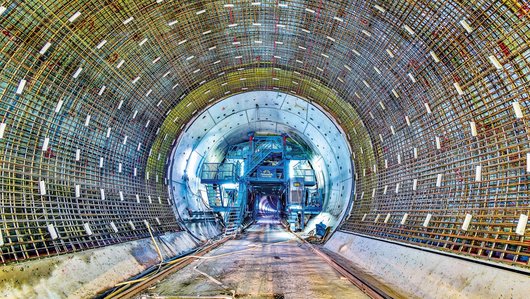

Circular construction: 5 smart strategies
The construction industry is an important cog in the circular economy. After all, the building sector is currently responsible for one third of global CO2 emissions. The goal of the circular economy is to save resources from the word go, to conserve them, and to keep them in the life cycle for as long as possible. Even at the planning stage, consideration must be paid to where building components and materials will end up later. Building sustainably means building in a way that is ecologically, socially and economically sustainable – for as many generations as possible. This calls for renewable raw materials and renewable energy. It is no longer possible to carelessly dump valuable materials or components or subject them to inefficient incineration. Reusing, recycling and re-purposing instead of binning is the answer to runaway waste. Technical innovations, new insights and smart planning are indispensable for circular construction.
1. Circular planning with BIM
Building Information Modeling facilitates the accurate 3D representation of buildings and infrastructure projects. From the initial draft floor plans to the final full fit-out, the programme calculates an exact building model. This is made possible by the standardised data collection and data exchange of all trades in real time. BIM provides a holistic representation of every phase of the project. This increases cost certainty, prevents planning errors and allows potential to be identified at an early stage – for example in terms of energy efficiency, material savings or subsequent use. PORR is considered a pioneer when it comes to BIM. It has embedded BIM in its LEAN management. And lean really does mean lean. The corporate philosophy calls for lean organisational structures and short, transparent information paths. Thanks to digital building models and efficient management, projects can be planned and calculated sustainably for their entire life cycle right from the get-go. All relevant information and data are then naturally available to the operators as well.


2. Low-emission construction sites
On the construction site, optimised operating times and efficient site logistics reduce emissions. As does the use of energy-efficient equipment and machinery. This is confirmed by CO2-neutral construction site, a research project by the Vienna University of Technology and the Resource Management Agency. According to the research, the reduction potential for greenhouse gas emissions on construction sites in 2023 “ranges from 21% to 52% depending on the type of construction site and general conditions”. PORR was quick to install smart metering systems at its facilities for energy monitoring and it uses solar energy at many of its sites. Processing excavated soil on construction sites reusing it locally are also smart strategies for circular construction, strategies that PORR is enthusiastically pursuing. PORR expert Katrin Maja Künzler explores the most important aspects of sustainable construction sites in a separate post.These primarily concern “the protection of biodiversity, soil and water conservation, as well as measures to reduce noise, visual and dust pollution”.
3. Renaissance and - further - development of materials
Traditional, natural construction materials like wood, clay and natural stone are having a renaissance. Their pros and cons are being analysed in detail, materials are being advanced and reinvented. For example, PORR developed a sustainable annular gap mortar for Deutsche Bahn together with MC-Bauchemie for the Filder Tunnel as part of Stuttgart 21. It replaces cement with blast furnace slag – a waste product found in steel production. 8% of global greenhouse gas emissions are generated in the production of cement. The fact that recycled products are added to the mortar instead reduces the burden on the environment twice over.


4. Re-purpose and re-use
Window frames, doors, shower cubicles etc. from existing buildings can often be reused. A prerequisite for this, however, is the digital recording of materials, for example with BIM. In addition, modular construction is once again in vogue. Modules can be quickly dismantled and reused elsewhere. So, if necessary, a student hall of residence can be converted into a senior citizens’ home in no time at all, or an empty office building can be rebuilt as a school at another location. Standardised dimensions and data transparency increase compatibility and simplify the re-use of entire modules or individual parts.
5. Properly sorted construction and recycling
To make it easier to reuse or recycle construction materials, proper sorting is a smart strategy. Clever joining methods make it simpler to separate the materials. For example, carpeting that is attached to the floor with Velcro instead of chemical adhesives can be easily reused elsewhere if the space is repurposed. And at the end of their useful life, the fibres without binders are easier to prepare for recycling. In the Recycling Center Himberg, around 400,000 tonnes of construction waste are given a new lease of life every year. “In the construction industry in general and in PORR in particular we always keep our eyes on the prize of the circular economy”, says Zeljko Vocinkic, Managing Director of PORR Bau GmbH and a recycling expert.
Did you know …
- … that PORR recycles 2.2 million tonnes of construction waste every year at facilities like Himberg and on its own construction sites? Of this, 1.7 million tonnes go to replace primary raw materials on site.
- … that PORR’s patented annular gap mortar is less sensitive to environmental influences than concrete that contains cement? In addition, it can be transported for a long time without any problems before processing since it requires an activator to harden.
- … that mineral wool waste in Austria is estimated to reach around 24,000 tonnes a year? PORR’s innovative processing plant dedicated to mineral wool waste reduces the volume by up to 80%. Research is still underway into other recycling and recovery options for mineral wool.


